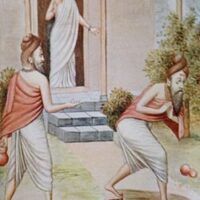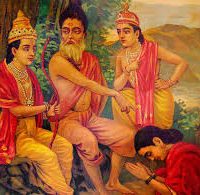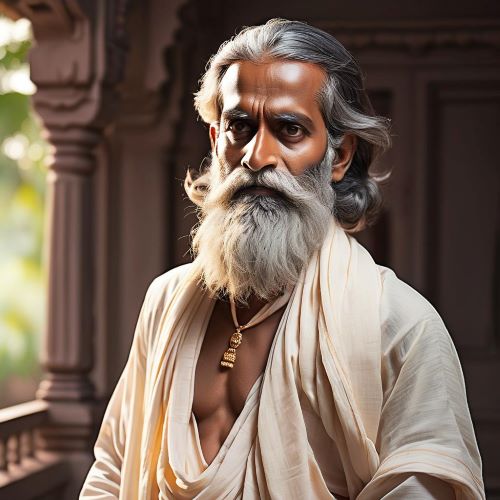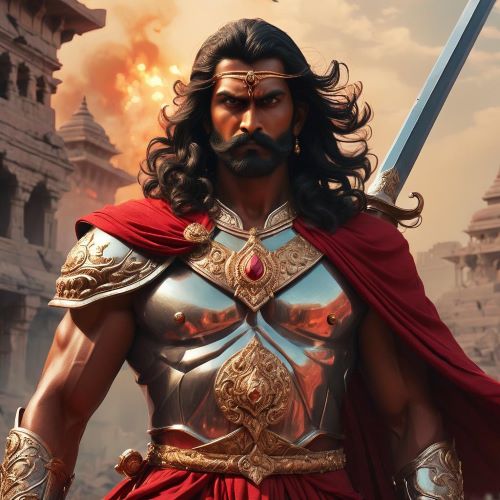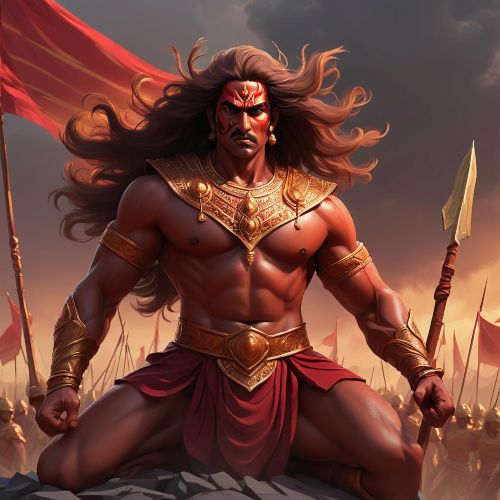Gautama : The Immortal of Discipline
Listen
At a glance
| Description | |
|---|---|
| Origin | Indian Mythology |
| Classification | Mortals |
| Family Members | Dirghatamas (Father), Ahalya (Wife), Shatananda, Sharadvana, Vamadeva, Nodhas, Cirakari, Jaya, Jayanti, Aparajita (Children) |
| Region | India |
| Associated With | Dharma, Discipline, Curses, Immortality |
Gautama
Introduction
Rishi Gautama, one of the most respected sages of Hindu tradition, is remembered as both a philosopher and a seer. Revered as one of the Saptarishis—the Seven Great Sages—he is celebrated for his contributions to Vedic wisdom, spiritual philosophy, and dharmic law. References to him appear throughout the Rigveda, Ramayana, Mahabharata, and numerous Puranas, underlining his enduring influence across centuries of Hindu thought. His name is especially associated with the Nyaya school of philosophy, which emphasizes reason, debate, and the pursuit of valid knowledge, as well as with the legendary tale of Ahalya, his wife, whose redemption became a central episode in the Ramayana.
Gautama’s role extended beyond philosophy; he was deeply connected with the transmission of sacred hymns, with texts crediting him as a “seer of mantras.” His spiritual practices, stories of intense penance, and his ability to alter destiny through both curses and blessings, reflect the extraordinary authority he carried in the ancient world. Today, Rishi Gautama stands as a symbol of dharma, austerity, and intellectual rigor in Hindu tradition.
Physical Traits
Unlike epic heroes or divine incarnations, sages were rarely described in terms of bodily grandeur. Rishi Gautama is therefore remembered less for physical form and more for his ascetic presence. Traditions and later iconography portray him as a radiant hermit with matted locks (jata), a flowing beard, and clothed in the simplest garments of bark and deer skin. His appearance symbolized renunciation and dedication to higher truths rather than worldly concerns.
Artistic depictions often show him carrying a kamandalu (water pot) and a danda (staff)—both standard emblems of ascetics. His eyes are sometimes described as sharp and penetrating, signifying his profound inner vision and ability to see beyond the ordinary. Through such imagery, Gautama is remembered as the embodiment of tapas, the spiritual fire of discipline, rather than as a figure defined by physical attributes.
Family
Rishi Gautama’s family is widely discussed in sacred literature, with variations in different texts. His parentage is attributed either to Dirghatamas or to Rahugana, and some traditions even trace his origin to the mind of Brahma, reflecting the divine recognition of his role as a sage.
His wife, Ahalya, remains one of the most prominent women in Hindu mythology. Crafted by Brahma himself, Ahalya was given in marriage to Gautama. Her story, marred by Indra’s deceit and followed by Gautama’s curse, is one of the most emotionally charged episodes in the Ramayana. Yet her eventual redemption by Rama highlights the themes of forgiveness and restoration that continue to resonate in Hindu cultural memory.
Gautama’s children were equally significant. Shatananda, his eldest son, became the chief priest of King Janaka in the Ramayana. In the Mahabharata, Sharadvana and Cirakari are mentioned as his sons, with Sharadvana’s lineage continuing through Kripa and Kripi, who played key roles in the epic. Other children named in the Rigveda include Vamadeva and Nodhas, both credited as composers of hymns. Texts like the Vamana Purana also speak of daughters—Jaya, Jayanti, and Aparajita—while folk traditions identify Anjana, the mother of Hanuman, as his daughter as well.
These accounts position Gautama not only as a sage but also as the patriarch of an enduring gotra (lineage) that remains prominent among Brahmin families today.
Other names
Throughout Hindu literature, Rishi Gautama appears under different names and epithets, each reflecting aspects of his stature. He is often called Maharishi Gautama, the title “Maharishi” highlighting his greatness among sages. In Vedic contexts, he is revered as a Mantra-drashtaa, meaning a seer of hymns, acknowledging his role in shaping sacred verses of the Rigveda. His inclusion as one of the Saptarishis underscores his position among the highest ranks of spiritual teachers.
In some texts, his name is spelled Gotama, a variant that signifies the same sage. His influence was so profound that even natural landmarks were named after him—the river Godavari is also known as Gautami, in honor of his role in bringing its waters to the earth. These names ensure that Gautama’s identity is remembered across philosophical, cultural, and geographical contexts.
Powers and Abilities
Rishi Gautama’s powers combined spiritual insight, mastery of rituals, and the ability to influence cosmic events. His ascetic penance earned him mystical authority, often expressed through boons and curses. The most famous example is his curse on Ahalya and Indra—transforming Ahalya into stone and punishing Indra with a thousand marks upon his body. These acts illustrate his control over karmic justice, as well as the immense potency of a sage’s spoken word.
Legends also associate him with the creation of the river Godavari, where his devotion brought divine waters to the earth for the benefit of humankind. This act not only symbolized his compassion but also tied his name forever to one of India’s holiest rivers.
Gautama’s greatest intellectual achievement was his authorship of the Nyaya Sutra, the foundational text of the Nyaya school of philosophy. This system emphasized logic, epistemology, and the search for truth through debate and reasoning. He also composed the Gautama Dharma Sutra, one of the earliest law codes, outlining duties of individuals, social rules, and guidelines for rulers. Together, these works established him as both a philosopher and a lawgiver.
The Mahabharata mentions his sixty-year-long penance, which reflects the extreme discipline through which he attained his powers. His devotion to Lord Shiva, marked by practices such as wearing Rudraksha beads, applying sacred ash, and chanting mantras, further enhanced his spiritual energy. These qualities ensured that Gautama’s influence extended from the ritualistic to the philosophical, shaping multiple dimensions of Hindu life.
Modern Day Influence
The legacy of Rishi Gautama endures in philosophy, culture, and religious practice. His Nyaya philosophy remains a cornerstone of classical Indian thought, continuing to inform debates on logic and reasoning in both traditional and modern contexts. Students of philosophy still study the Nyaya Sutra for its analysis of perception, inference, comparison, and testimony as valid means of knowledge.
The Gautama Dharma Sutra continues to be recognized as one of the earliest texts codifying dharma, influencing later legal and ethical writings. Its impact is seen in the ways Hindu society developed structured ideas of law, morality, and social duty.
The story of Ahalya’s redemption has left a deep cultural mark. It has been retold in countless forms—classical dance, temple sculptures, television epics, and literature—highlighting the enduring moral questions of temptation, justice, and forgiveness. Through this story, Rishi Gautama’s role continues to echo in collective memory.
His name also lives on through sacred sites. Places like the Gautam Kund at Chandrabani and the Gautameshwar Mahadev temple near Sihor draw pilgrims who believe in their spiritual power. The Godavari river, often called Gautami, remains one of India’s most revered rivers, further strengthening his presence in the religious geography of the subcontinent.
Even in modern contexts such as leadership and management, thinkers have drawn from the concept of “Rishi leadership”, inspired by sages like Gautama who were able to perceive truth beyond ordinary vision. His model of wisdom through logic and austerity is often cited as an ethical framework for contemporary challenges.
Rishi Gautama’s legacy thus bridges the ancient and the modern—preserving the sacred while continuing to inspire new ways of thinking. His name, teachings, and stories remain vital threads in the tapestry of Hindu philosophy and culture, ensuring that his influence endures across generations.
Related Images
Source
Wikipedia contributors. (2025). Gautama Maharishi. Wikipedia. https://en.wikipedia.org/wiki/Gautama_Maharishi
Gotras.com. (n.d.). Gautama Rishi Gotama: The Great Sage of Hindu Tradition. https://gotras.com/gautama/
Hindu Online. (n.d.). Gautama Maharishi. https://www.hinduonline.co/HinduReligion/Saints/Gautama.html
Contributors to Wikimedia projects. (n.d.). Gautama Maharishi – Wikipedia. https://en.wikipedia.org/wiki/Gautama_Maharishi
Gurprit Kaur. (2021). The Story Of Gautam Rishi And Ahliya – Blog Post – Basics Of Sikhi. https://www.basicsofsikhi.com/post/the-story-of-gautam-rishi-and-ahliya
Gautama Rishi: Significance and symbolism. (2024). https://www.wisdomlib.org/concept/gautama-rishi
Frequently Asked Questions
What is lorem Ipsum?
I am text block. Click edit button to change this text. Lorem ipsum dolor sit amet, consectetur adipiscing elit. Ut elit tellus, luctus nec ullamcorper mattis, pulvinar dapibus leo.
What is lorem Ipsum?
I am text block. Click edit button to change this text. Lorem ipsum dolor sit amet, consectetur adipiscing elit. Ut elit tellus, luctus nec ullamcorper mattis, pulvinar dapibus leo.
What is lorem Ipsum?
I am text block. Click edit button to change this text. Lorem ipsum dolor sit amet, consectetur adipiscing elit. Ut elit tellus, luctus nec ullamcorper mattis, pulvinar dapibus leo.
What is lorem Ipsum?
I am text block. Click edit button to change this text. Lorem ipsum dolor sit amet, consectetur adipiscing elit. Ut elit tellus, luctus nec ullamcorper mattis, pulvinar dapibus leo.
What is lorem Ipsum?
I am text block. Click edit button to change this text. Lorem ipsum dolor sit amet, consectetur adipiscing elit. Ut elit tellus, luctus nec ullamcorper mattis, pulvinar dapibus leo.



